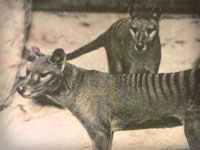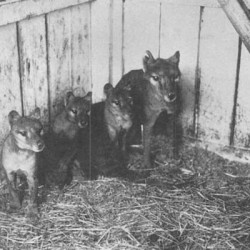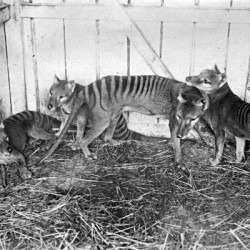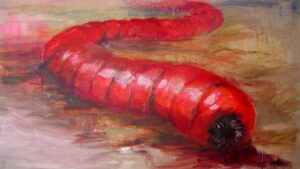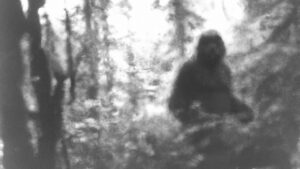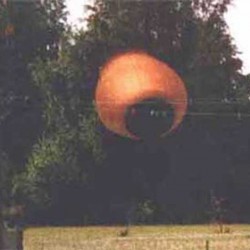So the Thylacine (Tasmanian Tiger) has finally been cleared of killing sheep – but the news comes 75 years too late! New studies suggests the Tasmanian Tiger’s jaw was not strong enough to kill sheep and the bounty on their heads was unjust!
This month marks the sad death of the last captive Tasmanian Tiger, know as Benjamin.
The last captive thylacine, later referred to as “Benjamin” (although its sex has never been confirmed) was captured in 1933 by Elias Churchill and sent to the Hobart Zoo where it lived for three years.
[youtube]http://www.youtube.com/watch?v=HBeAI5Vbl4A[/youtube]
Frank Darby who claimed to have been a keeper at Hobart Zoo, suggested “Benjamin” as having been the animal’s pet name in a newspaper article of May 1968. However no documentation exists to suggest that it ever had a pet name and Alison Reid (de facto curator at the zoo) and Michael Sharland (publicist for the zoo) denied that Frank Darby had ever worked at the zoo or that the name Benjamin was ever used for the animal.
Darby also appears to be the source for the claim that the last thylacine was a male – photographic evidence suggests it was female. This thylacine died on 7 September 1936. It is believed to have died as the result of neglect – locked out of its sheltered sleeping quarters, where it was exposed to a rare occurrence of extreme Tasmanian weather – extreme heat during the day and freezing temperatures at night.
Tasmanian tiger’s jaws were too weak to kill sheep, and at the end of the 19th Century, the thylacine had a price on its head.
The strange marsupial carnivore, which became extinct in 1936, was thought to kill sheep. Sheep farming was the backbone of the Australian economy, and the government duly set up a bounty scheme to exterminate the species.
But a new study has now revealed that the marsupial carnivore’s jaws were too weak to snare a struggling adult sheep.
As well as revealing the injustice of its being hunted, the study also suggests that the animal’s diet contributed significantly to its demise.
“They would need to hunt a lot of small animals to survive,” explained lead researcher Marie Attard from the University of New South Wales (UNSW) in Sydney.
“So just small disturbances to the ecosystem – such as those resulting from the way European settlers altered the land – would have reduced their odds of survival.”
Thursday marks the 75th anniversary of the death of what is believed to have been the last remaining thylacine, named Ben. The animal was kept at Hobart Zoo in Tasmania.
Thylacines, also known as Tasmanian tigers because of their striped back, used to roam throughout Australia and New Guinea. By the end of the 19th Century, Tasmania was the last refuge for a few remaining animals.
Source:
Tasmanian tiger’s jaws were too weak to kill sheep
Thylacine on Wikipedia

